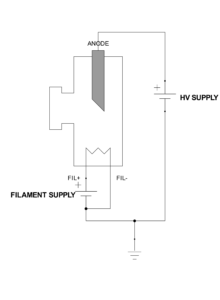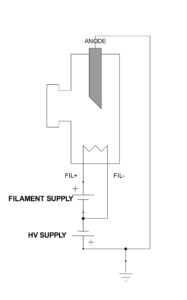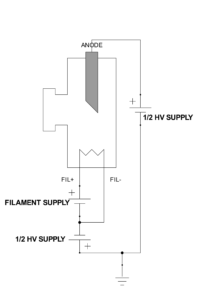X-ray Sources 101: X-ray Tube Topologies
What are X-ray tube topologies?
The topology of an X-ray tube refers to how the excitation voltage is generated inside the high voltage power supply. Determining which of the several common X-ray tube topologies is suitable for a high voltage supply is one of the first design decisions to make in any X-ray application.
An X-ray tube anode always has a high excitation voltage relative to the X-ray tube cathode. This is required so the electrons emitted from the electron gun see a large positive potential difference and accelerate towards the anode. Without this positive high voltage difference, X-ray generation would not be possible.
The most straightforward method is to put a high voltage supply on the tube’s anode, and a ground-referenced low voltage supply on the tube’s cathode. However, this is not the only way! Below, we’ll review three of the most common X-ray tube topologies.
Grounded Cathode Topology

This is the most common of MXR’s tube topologies. A grounded cathode means the cathode end of the tube is referenced to ground. In the case of a filament tube, this means one end of the filament is at the ground potential, and the other end is just a few volts higher. This makes for a simple filament control loop, which can be achieved with low voltage cables and (relatively) simple power supplies.
Grounded Anode Topology
This topology is the opposite of the grounded cathode. In this case, the anode side of the X-ray tube is referenced to ground, while the cathode side is referenced to (floats on top of) a negative high voltage. The voltage difference of the anode with respect to the cathode remains the same. This topology is useful in certain cases where reducing the focal spot to object distance (FOD) to the absolute minimum is required, as it allows the target to be moved extremely close to the X-ray window without worrying about high voltage fields near the grounded window. However, the floating filament supply requires relatively complex circuitry to monitor and control because it is floating many thousands of volts below the ground potential.
Bipolar Topology
A bipolar topology contains both a floating cathode and a floating anode. The advantage to this topology is that it allows you to use dual smaller, lower voltage supplies in order to achieve the same excitation voltage as a larger, higher voltage supply. For example, if your X-ray tube is designed for an 80kV excitation voltage, a bipolar supply will achieve this with dual 40kV supplies, one positive polarity and one negative polarity. This is advantageous because the creepage and clearance requirements on a single +80kV supply are much larger than on dual +/-40kV supplies.
Contact us today to learn more about our X-ray tube, source, and power supply offerings!






